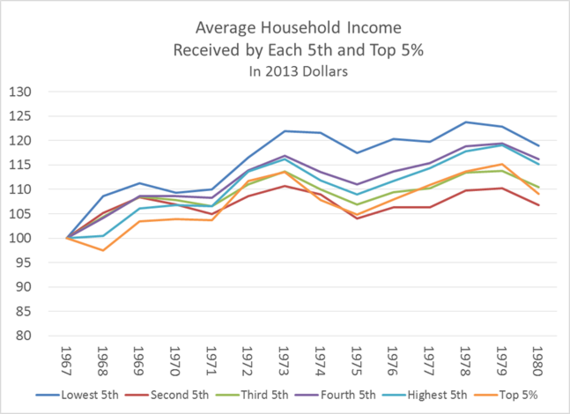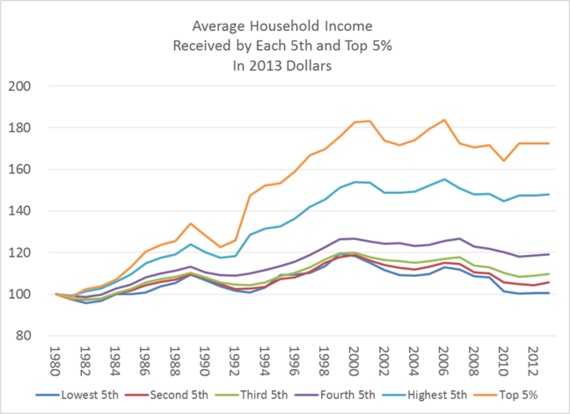Depending on which side of the aisle you favor, President Obama's State of the Union Speech last night was either a bold plan of action or a delusional rant. Liberal Democrats were pleased to hear the president revert back to the early days of his presidency when a Democratic House offered the possibility of pushing through at least some elements of his aggressive agenda. Conservative Republicans, on the other hand, probably received the speech as a polarizing, ideological rant consisting of big dreams that have no chance of being implemented given the backdrop of a Republican-controlled Congress. Wherever you stand on the political spectrum, I think there are some undeniable truths regarding our economy that need to be addressed before we reach the next phase of robust and sustainable economic growth.
But before I get any further, I would first say that the president's implicit characterization of the current state of the U.S. economy as strong remains premature. Massive increases in stock prices, largely induced by the Fed's easy-money policies, should not be (as they so often are) construed as an indicator of a robust economy. Conversely, plunging commodity prices and interest rates may not necessarily be a sign of a weakening in U.S. domestic growth. The answer likely lies somewhere in between: the economy continues to muddle along at a sluggish pace, and this is likely to continue.
I have talked at great length in prior pieces about how an unprecedented amount of stimulants have been required to achieve lackluster growth of 2.0-2.5 percent since the end of the Great Recession. The list below includes the items that I can think of at off the top of my head. Keep in mind that the removal or reversal of any of these stimulants would, at a minimum, act as a drag on future economic growth.
- A doubling (from 9 trillion to 18 trillion) in gross federal government debt
- A3.5 trillion increase in the size of the Fed's balance sheet
- A 200 percent increase in stock prices
- A drop in consumer savings rate to around 5 percent from the LT avg. of about 8.8 percent
- Government guarantees on the overwhelming majority of new mortgages
- An over 50 percent decrease in long-term interest rates (from around 4 percent to around 1.8 percent)
- A massive drop in energy prices
Now let me move on to another point I have hammered home many times over the past 10 years. Ever-expanding gaps in wealth and income are not a healthy recipe for robust and sustainable economic growth. I've maintained that the economy will only achieve "escape velocity" if and when the benefits of the recovery become more balanced. It is important to note that this statement is in no way an expression of political ideology, but rather it represents a firm belief that economic growth will be much more robust and sustainable when a larger extent of our productive capacity is being utilized. The more people working, earning income and spending, the greater the economic benefits. The masses move the needle, not the 1 percent at the top.
Using data from the U.S. Census Bureau in the charts below, I show the growth in inflation-adjusted income for each quintile of households, as well as the top 5 percent of households. The "Lowest 5th" represents the 20 percent of households earning the lowest incomes, while the "Highest 5th" represents the 20 percent of households earning the highest incomes. "Top 5 percent" is obviously the 5 percent of households earning the highest incomes. You will see that from 1967 (the first year for which we have data) through 1980, inflation-adjusted incomes actually grew the fastest among the Lowest 5th of households. There is a fairly tight range among the other categories.
The second chart shows the growth in inflation-adjusted incomes from 1980 through 2013. Here we see dramatic disparities based on income levels. The Top 5 percent of households have enjoyed a huge 72 percent increase in inflation-adjusted incomes, while the Highest 5th posted growth of 48 percent. The remaining quintiles saw incomes grow at much slower rates, with the least growth coming from the lowest-earning households. Incredibly, inflation-adjusted incomes for the Lowest 5th did not grow at all over this 33-year period!
I don't have all the answers. I don't know of any magic formula to lift up the less fortunate while preserving the system that has served us so well for generations. The President seems to believe that a Robin Hood strategy is the best course of action -- take from the rich and give to the poor. He proposes to increase capital gains taxes, inheritance taxes and taxes on financial institutions, and use the proceeds to support spending on education, tax credits for families with two working spouses, child care, health care research, infrastructure and other areas. Republicans, for their part, believe we need to overhaul of the tax code (to include lower corporate tax rates), balance the budget, amend or repeal an expensive Affordable Care Act (ObamaCare) and reduce regulation (to include the new regulations on financial institutions in the Dodd-Frank Act). The gap between these approaches is a mile wide, and therefore we are unlikely to make any meaningful progress prior to the 2016 elections.
It seems to me that the president is right about one thing when he said "...this country does best when everyone gets their fair shot." To that end, it seems we must make investments in both education and infrastructure so we remain competitive in a rapidly shrinking world. Where does the money come from? That's above my pay grade. But reducing the income and wealth disparities are likely to be the only successful long-term prescription for our sluggish economy.


